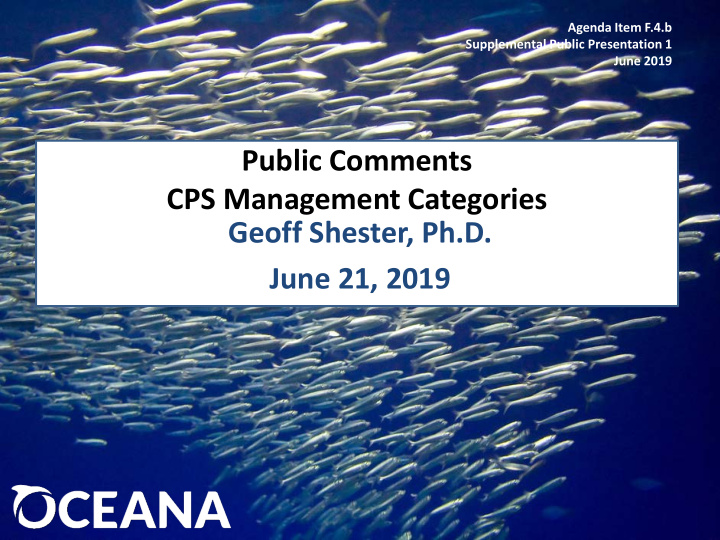



Agenda Item F.4.b Supplemental Public Presentation 1 June 2019 Public Comments CPS Management Categories Geoff Shester, Ph.D. June 21, 2019
Concerns with Council’s Implementation of CPS FMP “Monitored” Category Not using best available estimates of biomass to inform OFL, ABC, ACLs • Leads to less data being collected or reviewed • – no regular review of OFLs and ABCs by the SSC No way to determine whether stocks are overfished • – MSSTs missing for NSNA and jack mackerel – Abundance estimates not regularly reviewed against MSST (e.g., CSNA) Static quotas result in more severe collapse for highly variable stocks • Fails to prevent overfishing when stocks are low: 75% ABC buffer is not • sufficiently precautionary if stocks can drop by 99% in 2 years Not responsive to ecosystem concerns, does not achieve Optimum Yield •
Current categories California CPS Landings in 2018 do not reflect 18,000 recent biological 16,000 14,000 removals 12,000 Landings (mt) 10,000 8,000 6,000 4,000 2,000 0 Northern Pacific Pacific Jack anchovy mackerel sardine mackerel Monitored Active Monitored Active
Minimum Stock Size Thresholds • FMPs must contain Status Determination Criteria to determine whether stock is overfished • NMFS’ tool is MSSTs • Must be based on best available science MSST in FMP NMFS (2016) MSST Estimates Pacific sardine 50,000 mt 61,074 - 121,697 mt Pacific mackerel 18,200 mt 24,599 - 31,370 mt CSNA Not specified 69,049 - 69,781 mt NSNA Not specified Not complete Jack mackerel Not specified 272,160 mt
Proposed FMP Amendment There is no longer justification or need for the “monitored” category. Scope of proposed action : 1) establish an annual specifications process to set OFLs, ABCs, and ACLs for all 5 CPS fish stocks informed by annual estimates of abundance; 2) establish and/or update MSSTs for all stocks of CPS finfish in the FMP; and 3) eliminate the “active” and “monitored” management category terms.
Purposes of FMP Amendment • ensure consistency with National Standards 1 and 2 • ensure that the CPS FMP prevents overfishing • include clear status determination criteria for when stocks are overfished • use best available science • promote consistency with terminology across the Council’s FMPs • clarify the management strategies for CPS stocks CPS FMP.
A New Framework for CPS • Annual specification process for all 5 CPS finfish stocks: – Set OFLs, ABCs, and ACLs based on best available annual biomass estimates • Periodic Stock Assessments/ Management Strategy Evaluation (every 5 years) – Adjust MSSTs, Fmsy, Harvest Control Rules
Best Available Annual Biomass Estimates “2018 ATM review concluded acoustic trawl data represented the best scientific information available on an annual basis for assessing abundance of all members of the CPS assemblage, and approved the use of these data for directly (survey-based) or indirectly (model- based) assessing the status of the stock” -2019 Pacific mackerel assessment
Annual Specifications OFLs • Annual U.S. survey biomass x Fmsy ABCs • OFL x Uncertainty Buffer ACLs • Harvest guideline formula (with cutoff) Note: no need for “Distribution” term if surveys report U.S.-only biomass
CSNA Harvest Control Rule • Develop CSNA population simulation model • Evaluate and select among alternative control rules based on achieving Optimum Yield – Risk of collapse – Stability in catch limits – Economic variable – Availability to fish & wildlife predators
Our Requests • Initiate an FMP amendment at this meeting to: 1. Establish new MSSTs for all CPS stocks 2. Establish an annual specifications process for all 5 CPS fish stocks 3. Remove the active and monitored categories 4. Establish a new harvest control rule for CSNA
Recommend
More recommend